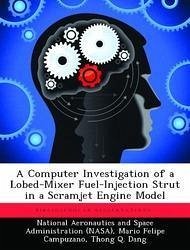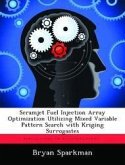A method of enhancing fuel/air mixing using streamwise vorticity for scramjet applications is presented. The generation of large-scale streamwise vortices is achieved by the incorporation of a lobed-mixer device into the fuel-injection struts of a proposed NASA scramjet engine. Conceptually, the lobed-mixer strut design is a three-dimensional lifting surface with a sinusoidal spanwise lift distribution. In the flow passage between the strut leading- and trailing-edges, the presence of a spanwise pressure gradient generates secondary flows. In the region behind the strut, which is a lifting surface, the shed vorticity system consists of periodic large-scale counter-rotating streamwise vortices. To evaluate this hypermixer concept, CFD calculations were carried out at supersonic combustor inlet Mach numbers ranging from 2 to 3 for cold flows. This concept is first analyzed for a 3D cascade of struts in inviscid flows. Results from this preliminary work reveal that significant secondary flows are generated in and behind the strut regions, while the additional shock losses associated with the lobed strut is small. Results confirm that the mechanism of generating streamwise vorticity is an inviscid phenomenon; the shed vorticity (i.e. streamwise vorticity) behind the strut is proportional to the pressure loading along the strut (Kutta-Joukowsky theorem). The next stage of this investigation considers the effects of viscosity on the generation of streamwise vorticity (or secondary flow). The geometry considered is a single lobed strut with "slip" side walls. Here, the NASA Reynolds-Averaged Navier-Stokes LARCK code (Langley Algorithm for Research in Chemical Kinetics) was used. Relative to the inviscid-flow results, in the absence of flow separation, viscous effects introduce blockage into the flow passage, causing a small reduction in pressure loading and hence a slight reduction in secondary flow.
Hinweis: Dieser Artikel kann nur an eine deutsche Lieferadresse ausgeliefert werden.
Hinweis: Dieser Artikel kann nur an eine deutsche Lieferadresse ausgeliefert werden.








